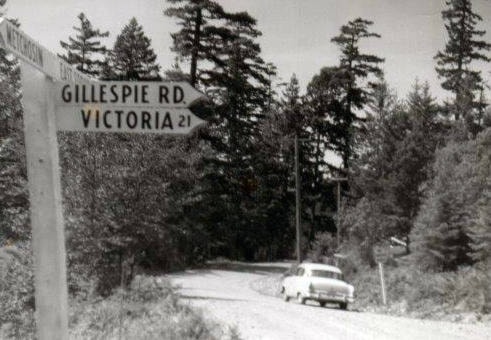Elida Peers | Contributed
Nowadays we whiz along on good highways that we take for granted, but it wasn’t always so.
The intersection shown in adjacent photograph, where Gillespie Road meets East Sooke Road, still exists today, 60 years after this photo, but the surroundings have changed quite a bit.
From a quiet meandering gravel and dirt route leading out to the far end of East Sooke Road, with homes sparsely situated along the way, to a well-travelled paved road (winding as it still is) now connecting many subdivisions and hundreds of new residents, yes, it’s changed quite a bit.
We asked Rob Hill about the parked vehicle and his classic car buddies think it’s an early 1950s Dodge.
Almost directly across from the sedan is where Bill Smith’s store has been since the mid-1990s.
At the time of the photo, when there were relatively few people living in East Sooke, a convenience store was unheard of, but as time went on and the subdivisions started, there was more of a tendency to express an interest in a local store, and eventually Smith built Bill’s Food and Feed, which today is known as East Sooke Grocery and General Store.
If you turned to the right, and went to the far end of East Sooke Road, you would have reached the pioneer Donaldson farm on the point (now Spirit Bear Farm), run at that time by Allie Donaldson.
It was in 1956 as well that there was a major windstorm which took down all the barns at the old Donaldson farm.
We asked Louise Paterson, a descendant of the pioneer Brown family, who grew up at Becher Bay and has many stories of earlier East Sooke, about the history of the road. Louise mused, “Well, the road did see lots of interesting activity, but I don’t think the rumrunners would have used the road at all, as they had fast boats to pick up the caches of liquor that were left at the ‘drop’ at the farthest point of land.”
In regards to heading the other direction on East Sooke Road, toward Becher Bay, Paterson remarked that it was her grandfather Percy J. Brown who picked up the liquor caches at Murder Bay during prohibition.
Paterson also chuckled about the time that the game warden dropped by her family’s home and was invited to stay for supper. Possibly the game warden didn’t know that the fine roast he joined the family in savouring was actually not beef, but out of season game.
•••
Elida Peers is the historian of the Sooke Region Museum.
editor@sookenewsmirror.com
Like us on Facebook and follow us on Twitter
